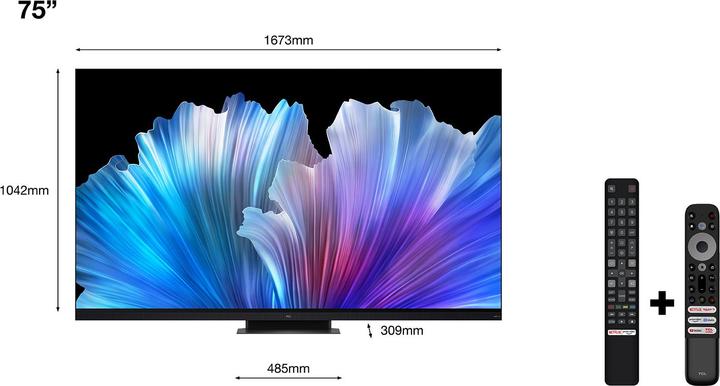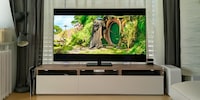
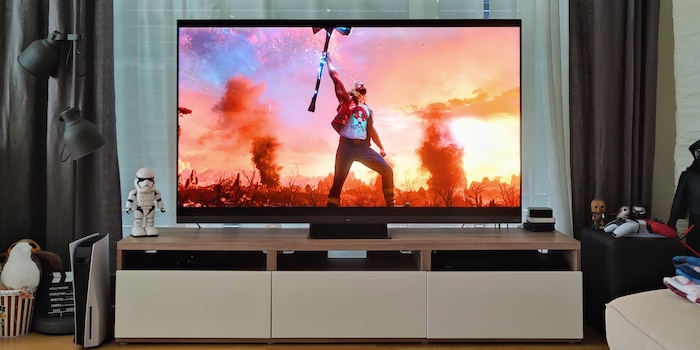
A lot of power comes from China: TCL's new mini LED TV in the test
It is already big. At least in China and North America. Now it wants to gain a foothold in Europe as well: Manufacturer TCL. With the C93 mini-LED TV, the neo-giant is raising high expectations - but does not quite meet them in the test.
When TCL - notably one of the largest TV manufacturers in the world - presented Mini LED at the end of 2019, the industry listened. The new backlight technology promises not only similarly good black levels for LCD TVs as for OLED TVs. It also wants to retain all the advantages of conventional LEDs. Say: good maximum brightness and no burn-in danger.
"Mini LED is not just as good as OLED. Mini LED is better," a euphoric Olivier Semenoux, Head of Product Management at TCL Europe, said to me in the interview at the time.
Two and a half years later, Semenoux's bold announcement has yet to come true. After all, advanced backlight technology is helping LCD TVs gain a much better standing in the battle against OLED. Samsung, LG and Sony have long been on board the mini-LED train for this reason. Accordingly, the C93, TCL's latest flagship, is not a revolution of the concept, but a consistent further development: more mini-LEDs, more thorough local dimming, less blooming, better picture and higher-quality sound - also thanks to Dolby Atmos support.
But the competition is not sleeping, they are literally upgrading. Samsung even managed to excite me with its mini-LED TV. TCL's C93 - that much in advance - does not succeed; the panel, which is great in itself, is still slowed down by the processor. This was already the case in 2020 with the mini-LED debut with the X10. Still, TCL is making steps in the right direction.
Full Disclosure: The TV, the 65-inch version, was provided to me by TCL for testing.
Design: top of the line and even with improved sound
The Chinese tech company's new flagship features a 144 Hz LCD panel with LED backlighting. This means that the image can be built up to 144 times per second. This is supposed to provide an ultra-smooth, smear-free picture, even though there is hardly any content on TV that even exploits such high frame rates. Number-blending? Maybe. You'll hardly use the TV as a PC monitor. Console games are currently optimised for 60 to 120 frames per second. And films and series are only shot at 24 frames per second anyway.
Typically for TCL, the panel is packed in a chic, thin aluminium frame. The two front speakers at the bottom of the screen are covered by an aluminium grille. On the rear side of the panel are two drivers radiating upwards - for Dolby Atmos sound - and a built-in subwoofer for bass. TCL emphasises that it developed the 2.1.2 system together with audio electronics manufacturer Onkyo. In practice, this actually sounds quite decent for a TV. But never good enough to replace a decent soundbar.
Truthfully? Anyone who buys a TV in this price category will not be satisfied with only halfway decent TV speakers. I'll therefore omit their in-depth analysis.
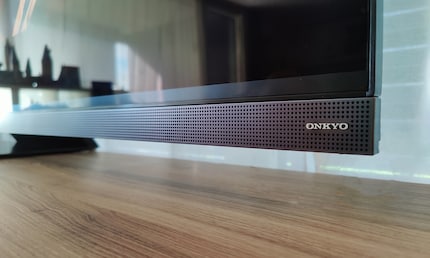
Source: Luca Fontana
Apropos: There are only about three centimetres between the lower edge of the TV and the TV furniture. This can be a problem with some soundbars - such as Sony's HT-A7000, which I recently tested: If the infrared sensor for the remote control is covered, turning the TV on and off becomes a cramp.
From the side, the C93 is quite thin for an LCD TV at 5.8 centimetres. Most are around six to seven centimetres thick. This is due to the additional LED layer that makes the LCD pixels in the panel shine. TCL's C93 also has such an LED layer. Only there are no conventional lamps, but mini LEDs. They not only provide better picture quality, but are above all much smaller. More on this later.
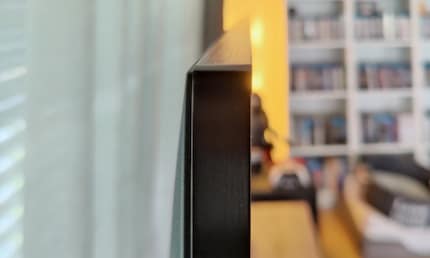
Source: Luca Fontana
Onto the specs. TCL offers the following:
- 4x HDMI 2.1 ports (4K144Hz, ALLM, FreeSync Premium Pro and HDMI Forum VRR)
- One of them with eARC (HDMI 3)
- 1x USB 2.0 port
- 1x output for Toslink
- 1x LAN port
- 1x CI+ 1.4
- Antenna ports
- Bluetooth 5.2
All four HDMI inputs support HLG, HDR10, HDR10+ and Dolby Vision. I think the latter in particular is cool. After all, TCL is one of the few TV manufacturers that does not offer either HDR10+ or Dolby Vision. Then there's Dolby Atmos, including passthrough, in case you want to pass the sound on to an external sound system.
Another thing I like is that it's got Dolby Atmos.
One more word about the weight. The TV weighs 32.4 kilograms. If you want to mount the TV on the wall, you will need a VESA 300×400mm mount. You can find it here in our shop
.
Mini LED in a Nutshell
To explain Mini LED to you properly would take a whole article. Well, I wrote that one earlier. If that's too long for you, here's the shorter form. If you just want to know how good the C93 is, you can skip right to the chapter "Measurements: High brightness, but no peak colour fidelity".
Let's move on to one of the most important features of the C93: Mini LED. This means that thousands of closely spaced LEDs provide the background light. This is because LCD pixels cannot light up by themselves, but must be illuminated from behind. And where pixels are supposed to remain black, the LED light is blocked by light crystals and polarisation filters - theoretically. In practice, however, a little light always penetrates through the pixel. That is why in LCD TVs, where there should be black, there tends to be dark grey.
TV manufacturers have therefore developed Full Array Local Dimming (FALD): Hundreds of LEDs that dim locally. This ensures better black levels - and thus better contrasts to rival OLED. In principle, "Mini LED" is like FALD. Only with thousands instead of hundreds of LEDs. This is possible because mini LEDs are much smaller than FALD LEDs. In the meantime, even 0.152 millimetres small mini LEDs are being built. In plain language: Mini LED is the logical further development of FALD.
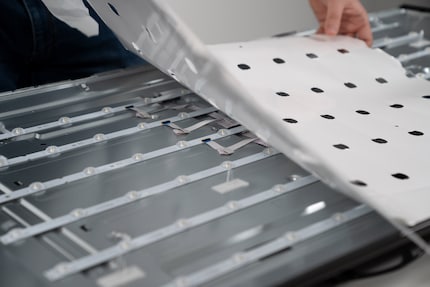
Source: Stephanie Tresch
Why are smaller LEDs better than big ones? First and foremost because they reduce annoying blooming, a kind of halo that occurs when bright edges against a dark background are not illuminated with pinpoint accuracy. Then LEDs also shine where there should actually be black. Several smaller LEDs, on the other hand, are more precise than a few large LEDs. And because there are many more LEDs in mini-LED TVs than in FALD TVs, there are also more dimmable zones and thus less blooming.
.
An example: the 65-inch model from LG's SM9900 series is said to have about 100 dimming zones. At the bottom of the LG picture on the right, pay attention to the faces, especially the Asian actor. It looks like a halo is following him. What is actually happening is that the background LEDs are not spotlighting the faces. As a result, the LEDs also shine on those pixels that should actually be black. On TCL's C93 - or Samsung's QN95B in the second comparison - on the other hand, you see nothing of the sort. According to Rtngs.com, there are over 700 dimming zones.
As you can see, thanks to mini-LED backlighting, TCL's C93 can dim locally pretty darn well. This gives it impressive blacks for an LCD TV - and thus better contrasts than its FALD siblings.
Measurements: High brightness, but no peak colour fidelity
What comes next goes even deeper than the mini-LED explanation above. If tables and diagrams don't interest you, you can skip all that and go straight to the chapter "The picture: Beautiful, accurate colours - but only with Dolby Vision". From there on, you'll find my subjective impressions with lots of video material.
Of course, I could only show filmed or photographed displays and point out strengths and weaknesses. Ultimately, however, I would only be reflecting my subjective perception. How bright, natural and true to colour a television really is can also be measured in figures. That has one advantage: numbers are more objective than I am.
To bring you this new service - so far it's only available on my reviews of Samsung's 2022 Neo QLED (QN95B), Sonys 2022 QD-OLED (A95K) and Samsung's 2022 QD-OLED (S95B) - we've been looking at professional tools acquired from Portrait Displays.
I measured out all the screen modes of the TV. From "Standard" to "Cinema" to "Dolby Vision", without calibration or manual changes in the settings. Just like most normal mortals use a television. After all, you want to know whether a TV is accurate and true to colour without expensive and professional calibration. I only switched off the sensors for automatic brightness. Nobody needs them.
The best values for all types of content - except for gaming, for which you should always use the game mode - were achieved with the "Dolby Vision" mode. The measurements listed below therefore always refer to "Dolby Vision". Except where there is no Dolby Vision as an HDR source. In this case, I used the "Cinema" mode.
The maximum brightness
The brightness is important for the TV for two reasons. On the one hand, it affects the contrast value. It determines how many different colours a TV can display. On the other hand, brightness is important if you often watch TV in rooms flooded with light. If a TV is not bright enough, it can be over-illuminated by the ambient light in the room. The picture will then look rather pale to you.
Let's look at the brightness of the C93. In the chart, I compare it directly with Samsung's QN95B, this year's mini LED competitor.
There are two axes: the vertical stands for brightness, the horizontal for the section in which the brightness is measured. At two per cent of the entire screen surface, i.e. selectively and with very small picture areas, TCL's C93 achieves an insanely high luminance value of over 2300 nit, even by LCD standards. And that's in Dolby Vision mode, which is rather darker than the TV's "standard" mode.
It is interesting to compare this with Samsung's QN95B. TCL clearly shines brighter at almost all window sizes. Except at full window size, where the difference shrinks down to a barely perceptible 23 nit. So I wouldn't say that TCL's TV is brighter per se. But TCL has more power where the pixels only need to shine brightly at specific points. For example, with lanterns, a sun or spotlights.
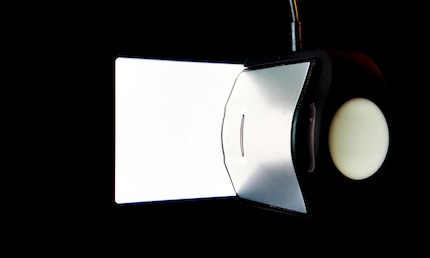
For classification: 681 nit is a lot. If you got 2300 nits on 100 per cent of the screen, it would burn your eyes out of your head. 681 nit, on the other hand, is more than enough to make out something on the picture even in a bright room during dark scenes. A typical characteristic of LCD TVs, by the way. OLED TVs are much less bright due to their technology. A lot of ambient light is therefore a problem for them.
The white balance
What exactly does white look like? That depends on the colour temperature. On the warmth or coldness of white. Warm tends towards yellow/orange. Cold tends towards blue. This in turn affects the representation of colours. In the industry, a white with 6500 Kelvin has been agreed upon for calibration, in short: white point D65. Most people would perceive this as a warm white, just like the resulting colours. This is also the case in "Dolby Vision" or "Cinema" mode. The whites and colours in "Standard" mode are much colder. For this reason alone, "Standard" mode does not produce an image worthy of reference.
White is created on the TV when the red, green and blue subpixels per pixel radiate simultaneously and equally. The full brightness therefore produces the brightest white. The lowest brightness, on the other hand, produces the deepest black. Everything in between is therefore nothing more than shades of grey. The accuracy of white balance is therefore measured with two tables:
- Grey scale delta E (dE)
- RGB balance
The greyscale dE shows how much the greyscale produced by the TV deviates from the reference value. The RGB balance shows in which direction the greyscales produced by the TV deviate from the reference value. Why is this important? Let's take a look at the concrete C93 example:
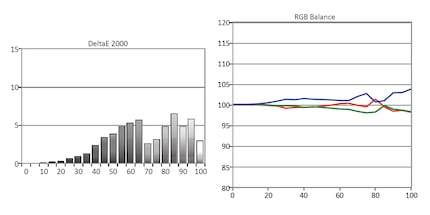
If you were to place the television directly next to a reference monitor, this would mean:
- Value is 5 or higher: most people can tell the difference from the reference monitor.
- Value between 3 and 5: Only experts and enthusiasts recognise the difference.
- Value between 1 and 3: Only experts recognise the difference, enthusiasts do not.
- Value below 1: Even female experts do not recognise the difference.
Any value below five is a very good value for a non-calibrated TV. TCL's C93 gets this right most of the time, but not consistently. On average, the average dE is 3.9 dE (dE Avg). That's a good figure, but not the best I've measured so far; that belongs to Samsung's S95B, a QD-OLED TV. This is no surprise: QD OLED TVs are likely to produce the best TV picture at present. Compared with Samsung's Neo-QLED TV and its average dE of 2.56, TCL's C93 nevertheless falls a little short.
.
A look at the RGB balance now shows to what extent the white balance deviates from the reference value. The whiter the white, the more noticeable a slight blue cast becomes. In other words, the blue subpixels radiate a little too strongly. But as I said, the deviation is just around dE 5. It is therefore very unlikely that you will actually perceive the blue cast as such in a real picture. Good marks, then, for TCL's C93.
The colour gamut
To continue with the colour gamut, the coverage of the most common colour spaces: the greater the contrast, the more colours can be displayed and the more natural the picture looks. This is why the gamut is important for HDR content, as its eponymous high dynamic range makes use of large colour spaces.
- Rec. 709: 16.7 million colours, standard colour space for SDR content such as live TV and Blu-Rays
- DCI-P3 uv: 1.07 billion colours, standard colour space for HDR content, from HDR10 to Dolby Vision
- Rec. 2020 / BT.2020 uv: 69 billion colours, hardly used in the film and series industry yet
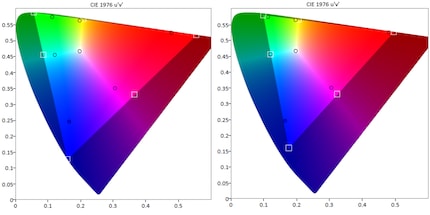
The large "colour blob", including the darkened areas, shows the full range of colours detectable by the human eye. The lightened area on the left shows the BT.2020 colour space. On the right, the same, simply the smaller DCI-P3 colour space. The white boxes show the actual boundaries of the respective colour spaces. The black circles, on the other hand, show the limits actually measured during measurement.
The measurement resulted in the following colour space coverage:
- Rec. 709: 100% (good = 100%)
- DCI-P3 uv: 86.11% (good = >90%)
- Rec. 2020 / BT.2020 uv: 61.54% (good = >90%)
The C93 thus comes to "only" 86.11 per cent coverage in the important DCI-P3 colour space. That's not outstanding, but still close enough to the benchmark not to pass as insufficient. Nevertheless, Samsung's Neo QLED achieves a very good coverage of 92.49% in this discipline for LCD TVs. OLED TVs even manage a little more. And QD OLED TVs achieve almost 100%.
The BT.2020 colour space, on the other hand, is less well covered by TCL's C93 at 61.54 per cent. For LCD TVs, values around 70 per cent would be more common. With corresponding content, this would lead to clearly visible compression on the C93. Dignity. As of today, even OLED TVs can hardly achieve 80 per cent BT.2020 coverage. Only QD OLED TVs barely reach the targeted 90 per cent. This is precisely why the film and series industry calibrates its HDR content almost exclusively in the much more widespread DCI-P3 colour space. The BT.2020 colour space is considered to be the colour space of the future and the coverage value is therefore only an indicator of future suitability.
Much more important, therefore, is the HDR colour space.
Much more important, therefore, is the colour error.
The colour error
For the television set, colours are not colours, but numbers. Numbers that precisely define the colours within a given colour space. For example, fire red. Ivy green. Or cadet blue. When you watch television, these numbers are sent to your television as metadata. It interprets the data and displays them as corresponding colours. Simple. Or?
No. TVs can indeed process and display most signals within the most common colour spaces. But that does not mean that they will accurately represent the colours. Otherwise, the picture would look exactly the same on all televisions. Therefore, the more the colours displayed correspond to those on reference monitors, the truer and better the television.
As with the greyscales above, the deviation of the TV from the reference value is called dE. The white boxes show the reference colours sent to the TV by the test pattern generator. The black circles, on the other hand, show the colours actually measured. Again, dE values below 5 are good for non-calibrated TVs.
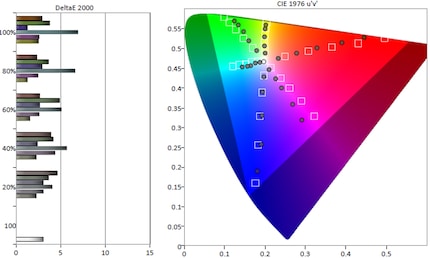
dEa BT.2020 Sweeps: 3.41 (max 7.45)
dEa P3 Sweeps: 3.39 (max 6.97)
The graph shows quite clearly: TCL's C93 has inherently good colour fidelity with Dolby Vision content. In fact, with a total of 40 readings, I measure an average dE of a good 3.39. That's not as good as the 2.97 of Samsung's Neo QLED. But close. Only with extremely saturated red, magenta and blue does the TV deviate a little too much from the norm. Sure, with a calibration, the value could be pushed even below 3, maybe even to just under 2. But the difference to a reference monitor, overall and with all the other colours together, is so small that even experts can hardly see it.
For comparison: in standard mode, the average dE was a miserable 17.42. Only Samsung's Neo QLED looks worse in standard mode with its 19.24. But TCL's cinema mode, which I always activate for non-Dolby Vision content, is also disappointing. There, the average dE was 7.54. That is far too high for the mode that is often praised by manufacturers as the "reference" mode. In fact, the "cinema" modes of other manufacturers, whose TVs I have had the opportunity to measure, are significantly better and, above all, below the targeted 5-dE limit.
Reflections
Reflections on the screen are not measurable per se. However, some of you have written to me and wished me to address them in my tests anyway. Good idea. To test this, I will recreate a normal situation in the living room: a photo during the day, without closed curtains, blinds or shutters. Behind me the oven, next to the TV the floor lamp. The light from the floor lamp is reflected by the glass of the oven behind me and thrown back onto the TV.
.
And here is the result:
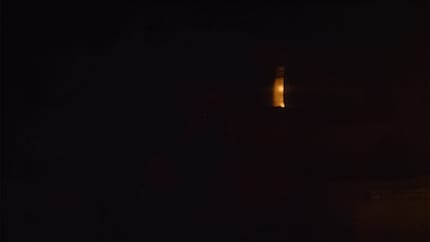
Source: Luca Fontana
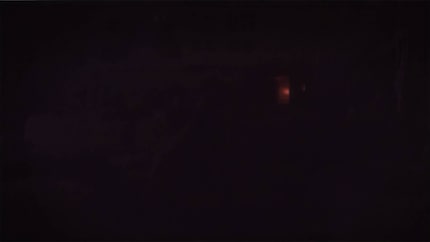
Source: Luca Fontana
The TCL C93 copes less well with direct reflections than, say, Samsung's S95B. Especially in the evening, the lamp can be really annoying when watching TV. During the day, however, reflections are hardly a problem. This is due more to the high brightness of the TV than to the rather average anti-reflective coating.
Intermediate conclusion after measurement
Let's draw a quick interim conclusion. TCL's C93 has a bright picture that is at its best in rooms flooded with light. In darkened rooms, however, OLED or QD OLED pictures look better. The most common colour spaces - Rec. 709 and DCI-P3 - are just adequately covered. The colour fidelity of Dolby Vision content is good. Only the "Cinema" mode is disappointing: Whereas its colour authenticity is always very good with other manufacturers, it is unsatisfactory with TCL.
The picture: beautiful, accurate colours - but only with Dolby Vision
Bright picture. Good colour with Dolby Vision. Less so with rest of HDR content. Theoretically. How does it look in practice?
Colour reproduction
It hardly gets more colourful than in "Guardians of the Galaxy, Vol. 2". Especially in this scene: the sunset-red scene in front of Ego's palace pops in saturated red. Drax's skin looks razor sharp. So sharp, in fact, that his blood-red tattoos are really highlighted. Compared to the mini-LED competition from Samsung, however, TCL's scene has a slight green cast. By the way, almost all the scenes I tested in which red is the dominant colour have this. Nothing wild, though. Without a direct comparison, it would hardly be noticeable. In the subsequent comparisons with Samsung's and Sony's QD OLED panels, however, the less intense colours are noticeable - an advantage of QD OLED technology.
Let's shift down a few gears. Colours don't always have to pop in the picture. For instance, in "James Bond - Skyfall", when James and the young quartermaster Q look at the picture of a proud old battleship being ignominiously towed to the scrapyard in an art museum. An allusion to the ageing secret agent, of course. As yet, I only have comparative material from Samsung for this scene. Nevertheless, the result is interesting. Here you can see the difference between Dolby Vision and conventional HDR. That's because Samsung is one of the few TV manufacturers that doesn't have a Dolby Vision licence.
The lack of Dolby Vision format is still one of Samsung's few major weaknesses: TCL's Dolby Vision picture looks pleasantly warm, powerful and yet natural. You can see this especially at minute 3:07 in the video above, if you pay attention to the skin tones and the wallpapers in the background.
Black Crush and Shadow Details
Not all scenes are bright. Some are really dark. That's why I want to test TCL's ability to show detail in dark areas of the picture. I don't make it easy for the C93. First, I compare it with Samsung's mini-LED competition. Then even directly with Samsung's and Sony's QD OLED TVs, which should display this scene much better. There is a very specific reason for this: OLED pixels emit their own light. With a UHD picture with over eight million pixels, that is de facto over eight million dimming zones. That's why OLED TVs can display perfect black, have better contrasts and no blooming at all.
In short: Dark scenes are their parade discipline.
Such as here, in "Blade Runner 2049". In the first comparison between the two mini-LED TVs, you can see well how the higher peak brightness on TCL gives my camera more trouble capturing the brightness properly than on Samsung. Especially in Ryan Gosling's close-up. TCL, however, handles the blooming around the windows a little better. In return, Samsung reproduces more details in the dark areas of the picture.
But the real eye-opener comes in the comparison with the QD OLEDs, above from minute 1:11. Look again for blooming around the windows. With both Samsung's and Sony's QD OLEDs, the scene looks wonderfully dark. If you film against the light, it is normal that the rest disappears in black silhouettes. That's why there's no question of black crush here - details that are swallowed up by the darkness. With TCL's mini-LED, on the other hand, areas are brightened that, in my opinion, should not be brightened. It looks wrong. Unnatural. Just: filming against the light.
Brightness gradations
A final image test: Brightness gradations. Due to the technology, it is mainly LCD TVs that flex their muscles here. Actually. In the following "Jurassic World" example, look at the sun in the background: Whereas the sun is clearly visible as a sphere in the firmament on Samsung, it outshines all the details in the sky on TCL. It is quite possible that the brightness control has its difficulties with so much brightness.
It's interesting, though, that Sony's QD OLED panel, of all things, handles the bright picture material best; to me, it seems brighter and yet more natural than its competitors. Especially when I pay attention to the skin tone.
Processor: good but not outstanding scores
The processor is the brain of the TV. Its main task is to receive, process and display picture signals. Processing means that it recognises poor picture quality and upgrades it. At TCL, it sounds like this: "Experience incredible picture details, just as the filmmakers intended. The picture you see is as detailed as in the real world. Dive even deeper into depth and detail!"
Behind all the sensational marketing gobbledygook is that the processor is supposed to remove noise, enhance colours, smooth edges, make motion smoother and add any missing pixel information.
Motion Processing and Judder
To start with, I make it really hard for the processor. Specifically: Judder, a phenomenon that all TVs have. Judder occurs when the picture signal and the TV panel do not have the same frame rate. With cinema films, for example. TCL's C93 can display up to 144 frames per second. Films, however, are shot at 24 frames per second. Processors synchronise this disparity with interframe calculations. If the processor is too aggressive in this process, the picture looks as exaggeratedly fluid as in a soap opera à la "Good Times, Bad Times". But if it holds back, the picture stutters. Especially during long camera pans. The film seems nervous - in English: jittery. The word "judder" has somehow been derived from this.
Sam Mendes' "1917" is full of such steady, slow-flowing camera movements and thus perfect for the judder test. Pay particular attention to the vertical bars in the barn when comparing it to other producers.
TCL apparently thinks a film has to jerk, nice and cinematic. Like the cinema used to be, before the digital age. But for me, the judder is too much. Fortunately, there are advanced picture settings: Under "Motion Flow", the judder reduction can be set more aggressively. This makes the stuttering less obtrusive - but I can't get rid of it completely.
Next scene from "1917". Again, Mendes' camerawork provides an immense challenge for most processors. Especially with hard edges in front of blurred backgrounds, for example around the helmets of the two soldiers. There, both the processor and the pixels have to react incredibly quickly.
This is where TCL's processor does better, even if it doesn't flex its muscles quite as much as Samsung's or Sony's processor. Nevertheless, the picture flows, but never looks unnatural. In addition, the colour temperature is precisely set. Only in the dark areas do the QD OLED panels play a league above: the perfect black gives the picture that extra punch and adds depth to the scene.
Pixel response time
Next up, the Apple original "For All Mankind". I want to see how long a single pixel takes to change colour. If it doesn't happen fast enough, it looks to you like the image is streaking - the effect is called "ghosting". Here I compare with TCL's C82, the direct predecessor of the C93 mini LED TV. As the camera pans across the lunar surface, look for the text below. Then you will see the streaks I am talking about on the right side of the C82. With the C93 on the left, on the other hand, you see almost nothing. That speaks for a clearly better processor.
Not bad, TCL. Because it's hard for LCD TVs to display this scene free of streaks. This is shown by the second comparison with Samsung's mini LED TV. Pay particular attention to the colon there. The QD OLED TVs after that don't give a damn at all. That doesn't surprise me. OLED TVs have excellent response times due to the technology. That's why they are also considered exquisite gaming monitors. LCD TVs are at a disadvantage in that regard.
Upscaling
Now for the most difficult test. This time I want to see how well the processor upscales lower quality sources. Blu-rays or good old live television, for example. Or "The Walking Dead". The series was deliberately shot on 16mm film to create the feeling of a broken, post-apocalyptic world with old-fashioned grain along with picture noise.
TCL's C93 is capable of upscaling. To put it in perspective, that's an SDR-quality HD source upscaling its 2 million or so pixels to 8.3 million pixels. In other words, 75 per cent of the image is calculated. Sharpness and edge smoothing are very good. Noise between the two actors is almost completely eliminated. I even like this better with TCL than with Sony - there it looks too much like snow flurries to me. In comparison, you can see how much more natural the colours of the "cinema" modes of the other manufacturers are.
Gaming: Input lag and game mode
Is the TV also suitable for gaming? Absolutely. In fact, when I measure the colour error, I get a dE of just 4.19. That's not just below the targeted dE-5 limit for "cinema" modes. This is the lowest dE I have ever measured in a game mode - and then it is even below the aforementioned limit. In plain language, this means that the colours are incredibly well calibrated for a game mode. That is not normal. Game modes reduce unnecessary image enhancement metadata for gaming. This reduces processing time and consequently input lag on the TV - at the expense of picture quality. I've already written about this here. TCL's Game Mode does that too. But in such a way that the colours are still displayed correctly. This is great class.
In fact, with the meter from Leo Bodnar, I measure an average input lag of a very good 12 milliseconds, without seeing too serious a drop in picture quality. Furthermore, the TV supports all features relevant for gamers:
- 4x HDMI 2.1 ports (4K144Hz / 8K60Hz)
- Auto Low Latency Mode (ALLM)
- Variable Frame Rates (AMD Freesync Premium and HDMI Forum VRR)
To this end, TCL - just like LG, Samsung, Sony, Philips and Panasonic - has partnered with many major gaming studios. The result: HGiG - HDR Gaming Interest Group. According to the manufacturer, this should ensure that HDR is displayed as the game developers intended. For example, when playing "Spider-Man: Miles Morales" on my Playstation 5.
I am pleased to note that the colours are pleasantly warm, black is really black, the edges look sharp and the picture does not blur too much even during fast and jerky camera pans. Notice Miles' dark silhouette against the light, the detailed textures of snowy New York or the clearly visible details in the clouds. This is what a good game mode looks like.
Nice: Similar to LG or Samsung, TCL also offers a dedicated submenu in which you can make fine adjustments for gaming and read off the current frame rate. Very important: TCL's C93 supports the new VRR 120Hz mode of the PS5 without any problems.
Smart TV: Google TV
TCL is betting on Google TV. This is Google's own custom ROM layered on top of the open source Android TV software. Or simply put, an operating system that lets you access apps like Netflix, Amazon Prime, Disney+ or the Play Store from one place. The Google TV interface is tidy and displays cross-app movie and series suggestions. So far, so great.
On the other hand, I notice slight delays when using it. Apps don't load as quickly as I'm used to from other manufacturers. And crashes are not the order of the day, but they happened again and again during the one-month test phase. I know this differently: on Sony's A95K, which is also equipped with Google TV, the smart TV user interface feels a lot smoother and more responsive.
Conclusion: Not yet enough for a top spot
TCL still wants to conquer the European market. They already dominate China. North America too - both markets that have made the Chinese tech company one of the biggest TV manufacturers in the world.
Will TCL also conquer the European market?
If TCL wants to become big in this country, too, it needs a good name. A reputation as a premium TV manufacturer. To achieve this, the Chinese tech giant is investing heavily in partnerships with famous athletes such as Marco Reus or Paul Pogba. At the same time, new technologies and novel production processes are constantly being researched. For example, an OLED layer to be printed on a wafer-thin layer of glass, like ink on paper in an inkjet printer. This makes TCL an exciting player in the TV game.
In terms of price, TCL actually plays well. Its direct competitor, Samsung's QN95A - also with mini-LED backlight - costs about 200 francs more. In addition, TCL can boast Dolby Vision. Samsung does not. If I had to choose, I would still go for the South Korean TV. Because while TCL's Dolby Vision picture is accurate (not quite as accurate as the competition's), it clearly loses out on all other film and series content. The "Cinema" mode in particular disappointed me bitterly: without calibration, it gets unsatisfactory marks. Only in gaming did the Chinese TV produce the best picture I have ever tested - and with low input lag. That means something. The competitors included Sony's A95K and Samsung's S95B, two QD OLED TVs.
Summa summarum: The tech giant can't quite keep up with the top yet. For that, the TV would need a more powerful processor. I can already feel this when I switch it on for the first time while using the Google TV user interface. TCL's vision of being the biggest and most advanced TV manufacturer remains just that for now - a vision.
I write about technology as if it were cinema, and about films as if they were real life. Between bits and blockbusters, I’m after stories that move people, not just generate clicks. And yes – sometimes I listen to film scores louder than I probably should.

